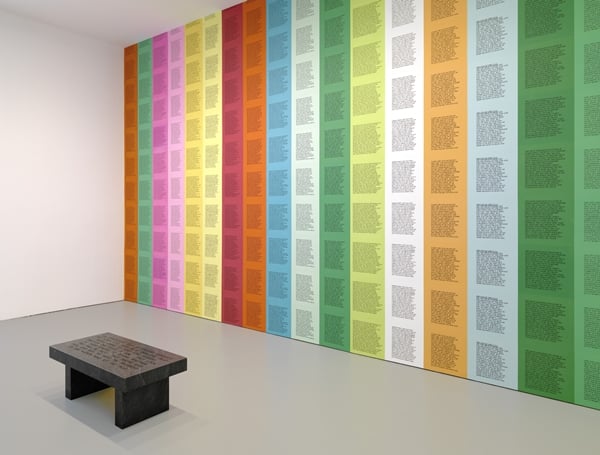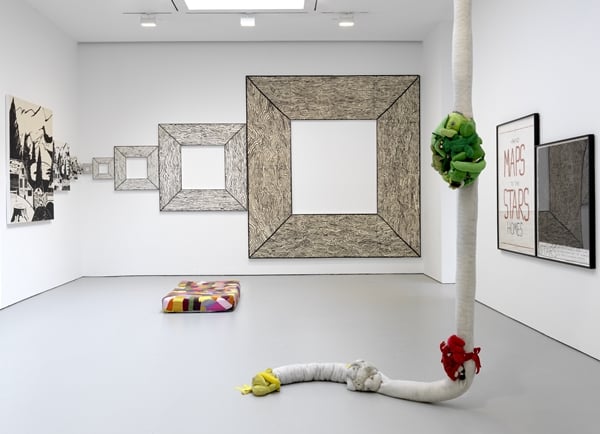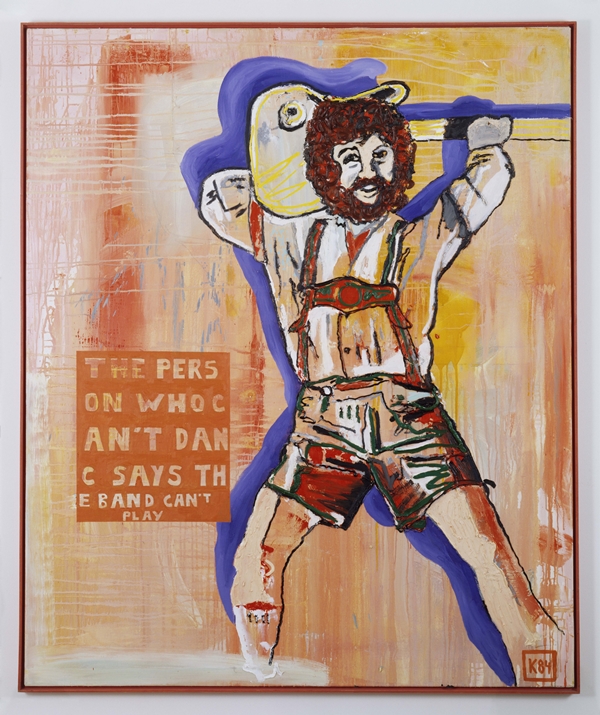Reviews
David Zwirner Romances History, Rewrites History
"No Problem: Cologne/New York 1984–1989" makes a case for the primacy of Cologne.

"No Problem: Cologne/New York 1984–1989" makes a case for the primacy of Cologne.

Christian Viveros-Fauné

Who writes art history? Since the 1980s the answer has largely been the art market and its biggest operators. As that market becomes increasingly financialized, the number of players capable of shaping the contemporary canon has become smaller and less varied. Among the biggest oligarchs of visual culture is David Zwirner. A pioneer of 21st century gallery moguling and a scion of old school art dealing—his father was the gallerist and art fair director Rudolf Zwirner—he has most recently turned his hand to curating. His latest effort, “No Problem: Cologne/New York 1984–1989,” writes art history in gold leaf and embossed letters.
Seen one way, Zwirner’s romancing of art history is a vapid, hot mess—consider the chocolate-covered marshmallow that is the Oscar Murillo show at the dealer’s 19th Street project space. On the other hand, “No Problem: Cologne/New York 1984–1989” presents a bona fide museum-quality, blockbuster display (among other firsts, it marks the first time Zwirner’s 19th and 20th Street spaces have been used for a single exhibition). A snapshot of 1980s creativity as it played out in twin art capitals, “No Problem” tracks artistic influence but also provides a portrait of a key cohort of international art dealers. Part of the crew that first embraced the cultural and economic logic of globalization, gallery powerhouses like Max Hetzler, Sprüth Magers, Barbara Gladstone, Metro Pictures, Matthew Marks, and David’s own father, Rudolf, feature prominently in this group picture.

Installation view, “No-Problem: Cologne/New-York (1984–1989), David Zwirner New York, 2014. Photo: Courtesy David Zwirner, New York/London. All artwork © 2014 the artists.
Given that these galleries carried on important transatlantic exchanges with themselves, “No Problem” makes a convincing case that—after Paris and before Berlin—Cologne was where the creative action was in 1980s Europe. Painting giants Sigmar Polke and Gerhard Richter moved there, respectively in 1978 and 1983, diminishing the intellectual pull of Dusseldorf’s legendary academy. Though aloof from the scene, the two big art Teutons helped draw attention to what eventually became ground zero for European art production. Back then, it bears remembering, the art world was still a place for unmarketable ideas—but one increasingly assailed by big money and cozy influences in a period made infamous by the first modern art-investment panic and an $87 million Portrait of Doctor Gachet.
In the mid-1980s, plugged-in Cologne galleries weaned on postwar American art began hosting exhibitions by young artists popular in New York, among them Mike Kelley, Cindy Sherman, Sherrie Levine, Barbara Kruger, Jenny Holzer, Robert Gober, Richard Prince, Jeff Koons, George Condo, Raymond Pettibon, and Christopher Wool. Smart American galleries returned the favor with equally prominent shows of German and Mitteleuropean kunstlers, which included Martin Kippenberger, Albert Oehlen, Rosemarie Trockel, Günther Förg, Walter Dahn, Georg Herold, the Austrian Franz West and the Swiss duo of Peter Fischli and David Weiss. All of these artists have multiple works in “No Problem,” making for a series of compelling mano-a-mano encounters among old pals and longtime opponents. After half a decade of to-ing and fro-ing, Zwirner’s stocktaking exhibition argues, both artists and galleries managed to arrive at connections that remain historically unique.
The kinship between the artists on view in “No Problem” is, in a word, evidentiary. What the gallery press release refers to as the “influences, affinities, and dialogues” inspired by the New York–Cologne nexus can be summed up in the following litany: punk, politics, provocation, and the enshrinement of bad taste. There were, for example, repeated comical, anti-authoritarian stabs at a DIY aesthetic, as seen in works by Franz West, Mike Kelley, and Fischli/Weiss. Other 80s exemplars, like Jenny Holzer, Rosemarie Trockel, Barbara Kruger, and Gunther Forg turned to politics, the latter by pioneering large-scale photographs of Italian fascist architecture. Still, another group of artists, like Cindy Sherman and Albert Oehlen, explored abjectness with epochal abandon. At Zwirner, Sherman is represented by her comparatively unpopular color photos of pustulant bottoms and pools of vomit; Oehlen, by a painted self-portrait with shitty underpants holding the world’s most expensive stamp, a Blue Mauritius.

Martin Kippenberger, The Person who can’t dance says the band can’t play (1984)
Photo: © Estate Martin Kippenberger, Galerie Gisela Capitain, Cologne.
Elsewhere in “No Problem,” Cologne’s premier bad boy, Martin Kippenberger, squares off with America’s king of banality, Jeff Koons, in a single 19th Street gallery that holds a number of period works by each. The effect is bracing. Rather than call up similarities among the button-pushing works of each artist, the invited comparisons favor the anarchic, self-immolating energy of Kippenberger. Dead or alive, he calls out Koons’ millimetrically calculated excess for what it is—a lightweight reflection on commodity fetishism, this time in the form of kitsch statuary.
Ultimately, what “No Problem” tracks is neither a school, nor a movement, nor a style. It is, instead, a coordinated history. That script—as this show properly demonstrates—is written by the winners. One glimpse at the anemic, overvalued works by Koons and Richard Prince in this otherwise fascinating, deliberately revisionist show makes that fact abundantly clear.